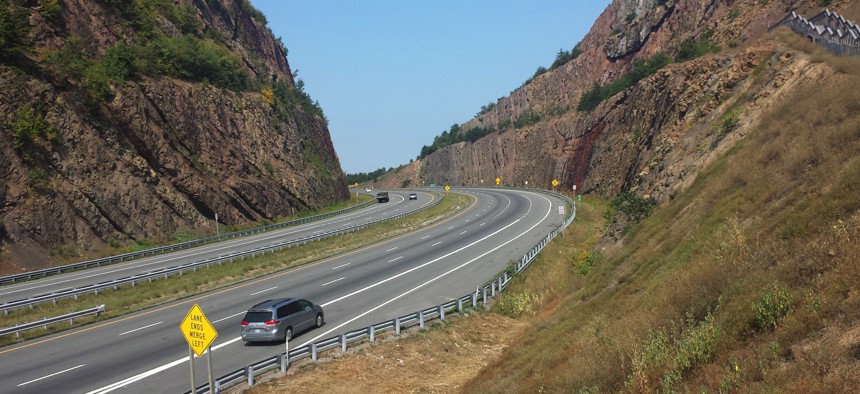Route Fifty City-County Roadtrip Recap: Sideling Hill, the National Road and the Way West

Interstate 68 passes through this gap through Sideling Hill. Michael Grass / RouteFifty.com

Connecting state and local government leaders
The route through Western Maryland has long been a historic way through the mountains. And one passage is a major geologic wonder.
Route Fifty is currently featuring dispatches from a city-county summer roadtrip in Maryland, West Virginia, Pennsylvania, Ohio, Michigan and elsewhere along the way. An Introduction to the Series | Previous Stop: Frederick, Maryland
SIDELING HILL, Md. — Driving west along Interstate 70 approaching Hancock, you can see the giant manmade gap through Sideling Hill off in the distance. It’s at Hancock where Maryland’s western panhandle is at its narrowest—it’s less than two miles in width—I-70 turns northward toward the Breezewood junction of the Pennsylvania Turnpike; across the Potomac River is West Virginia.
Interstate 68, aka the National Freeway, branches off I-70 at Hancock and continues west, roughly following the route of the historic National Road into Western Maryland. This is Washington County, the first Washington-named county I will pass through on this trip. (Technically, before the District of Columbia was consolidated into its current unified jurisdiction in 1871, there was once the City of Washington and Washington County … and I started my city-county summer roadtrip in what was once the Washington County portion of the nation’s capital.)
Many hours after I had passed through Washington County that Sunday, there was a tragic accident on I-70 near Hagerstown. Lenny Robinson, better known as the “Route 29 Batman” who would travel around in a custom Lamborghini trying to cheer up sick children while dressed up as Batman, was killed along the side of the freeway in an accident involving his Batmobile.
As The Washington Post reported this week:
His car was stopped in the median but still “partially in the fast lane” when he got out to check the engine, according to state police. Around 10:30 p.m., a Toyota Camry slammed into the Batmobile, propelling the steel-framed hunk of black metal into his body. Robinson, 51, died at the scene. His funeral is scheduled for Wednesday in Owings Mill, Md.
That section of I-70 is an especially busy corridor, frequented by long-haul traffic heading through the Appalachian Mountains going to and from the Baltimore-Washington region and the Midwest.
This way west has been an important route historically.
The Chesapeake & Ohio Canal, which never made it to Ohio, was built along the Potomac River up to Cumberland in Western Maryland. The Baltimore & Ohio Railroad, one of the earliest railroads in the United States, connected the ports of Baltimore to points west, including Pittsburgh, Cincinnati, Chicago and St. Louis. To get around topographical obstacles like Sideling Hill, the B&O crossed through the vicinity south of Potomac River in what is now West Virginia.

Then there was the National Road, a major early overland route west through the mountains and the first improved road built by the federal government. It technically started in Cumberland, Maryland and stretched west to Vandalia, Illinois, via Wheeling and Indianapolis. But privately-built roads connecting Baltimore and Frederick with Cumberland also became known as the National Road or Baltimore National Pike. U.S. Route 40 would eventually follow the National Road’s way through Western Maryland and into Southwest Pennsylvania.
Parts of U.S. 40 were shifted to freeway alignments over the years, while some original sections of the National Road became Maryland State Highway 144, which if you ever have time, is very scenic.
By 1991, I-68 would be complete between Hancock, Maryland, and Morgantown, West Virginia, offering an alternative—and toll-free—route west that avoided the Pennsylvania Turnpike. It’s a scenic route through the mountains.
For the National Freeway, the state of Maryland chose to blast its way through Sideling Hill.
There’s a rest area where I-68 cuts through the 340-foot-deep mountain gap, revealing some amazing geological layers that were formed 330 to 345 million years ago. “Almost 810 feet of strata in a tightly folded syncline are exposed in this road cut,” according to the Maryland Geological Survey.
Sadly, the visitor center at the Sideling Hill rest area has been closed since 2009 due to state budget cuts. But you can still can get some great views of the exposed geology.
Onward!
Next Stop: Waynesburg, Pennsylvania
Michael Grass is Executive Editor of Government Executive’s Route Fifty.

NEXT STORY: In 3 States, an Overwhelming Response to New Driver’s Licenses for Undocumented Immigrants





